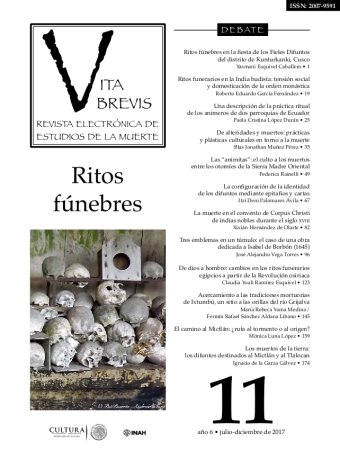Publicado 2018-01-24
Palabras clave
- Budismo,
- muerte,
- rito,
- funerario,
- monacato
- monástico. Buddhism,
- death,
- Rite,
- funerary,
- monasticism,
- monastic ...Más
Cómo citar
Resumen
Resumen
La muerte es un tema central en el budismo. Representa un constante recordatorio de la impermanencia de todos los fenómenos, incluyendo la vida humana. Ahora bien, para el budismo monástico el cadáver carecía de importancia y, en su época más temprana, la orden budista no trataba los restos del difunto con ritos funerarios. Sin embargo, esta situación cambió y rápidamente se establecieron formas precisas de tratar el cadáver. De acuerdo a algunas fuentes antiguas las motivaciones para introducir estos cambios no fueron necesariamente sanitarias o rituales, sino que obedecieron a la necesidad que tenía la sociedad en general de honrar a los difuntos. En este trabajo se aborda la tensión existente entre la posición monástica, más inclinada hacia el rechazo del cuerpo, y la postura de la sociedad en general, cuya visión del mundo exigía un tratamiento cuidadoso del cadáver.
Abstract
Death is a central theme in Buddhism. It represents a constant reminder of the impermanence of all phenomena, including human life. However, for monastic Buddhism the corpse was of no importance, and in its earliest time the Buddhist order did not treat the remains of the deceased with burial rites. This situation changed and precise ways of treating the corpse were quickly established. According to some ancient sources the motivations for introducing these changes were not necessarily sanitary or ritual, but obeyed the society's general need to honor the departed. In this work I address the tension between the monastic position, more inclined toward the rejection of the body, and the position of society in general, whose world view required a careful treatment of the corpse.
Descargas
Referencias
- Davids, Rhys (trad.), 1880. “The Four Visions”, en Buddhist Birth-Stories, Londres, Trübner, Pp. 166-168.
- Hirakawa, Akira, 1990. “Birthdate of the Buddha”, en A history of Indian Buddhism: From Śākyamuni to early Mahāyāna, Honolulu, University of Hawaii Press, Pp. 22-24.
- Jones, J.J. (trad.), 1952. “The Great Renunciation again”, en Mahāvastu II, Londres, Luzac, Pp. 134-161
- López, Donald, 2009. “El Universo”, en El Buddhismo. Introducción a su historia y enseñanzas, Barcelona, Kairós, Pp. 53-78.
- Olivelle, Patrick (trad.), 2008. “Canto 3. Becoming Dejected”, en Life of the Buddha, Nueva York, New York University Press, Pp. 59-84.
- Penner, Hans, 2009. “Enlightenment and Liberation”, en Rediscovering the Buddha. Legends of the Buddha and Their Interpretation, Nueva York, Oxford University Press, Pp. 33-37.
- Shaw, Sarah, 2006. “The ten foulness (asubha)”, en Buddhist Meditation. An anthology of texts from the Pali canon, Londres, Routledge, Pp. 101-108.
- Schopen, Gregory, 1997. “On Avoiding Ghosts and Social Censure. Monastic Funerals in the Mūlasarvāstivāda-vinaya”, en Bones, Stones, and Buddhist Monks, Hawai, University of Hawai'i Press, Pp. 204-237.

